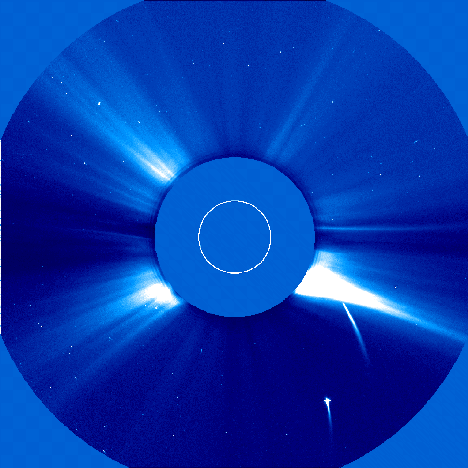
|
SOHO took this image is to look at the stream of material leaving the Sun. The Sun itself is blocked out in the center (orange circle) to allow the much dimmer surrounding environment to be photographed. The bright streaks leaving the circle are plumes of solar wind leaving the Sun. This is a side view, but somewhat above what we can see from Earth. The comet is the long streak arching from the left toward the Sun. The solar wind is blowing vapor, dust, and ion back away from the comet nucleus to create the tail. This comet was destroyed after it plunged into the Sun. Image taken on Dec. 23, 1996.
This was a rare treat for comet sadists: Two comets plunged into the Sun within a day of each other (June 1 and 2, 2000). Again, the comets are the curved streaks that get brighter toward the Sun (which is blocked out by the blue circle). So how many comets are there? There are long-period comets that take more than 200 years to complete an orbit and short-period comets. Many long-period comets are in orbits that take them up to 1/3 the distance to the nearest star and take up to 10 million years to complete an orbit. These long period comets occupy the Oort Cloud and may number in the trillions! The short-period comets occupy the Kuiper Belt (beyond orbit of Neptune), typically have periods of less than 10 years, and number between 100 million and 1 billion! So, a few comets diving into the Sun each year really do not affect the total number of comets! Back to Planetary Formation web pageImage credits and caption information: SOHO web site |
![]()
|
|
|

